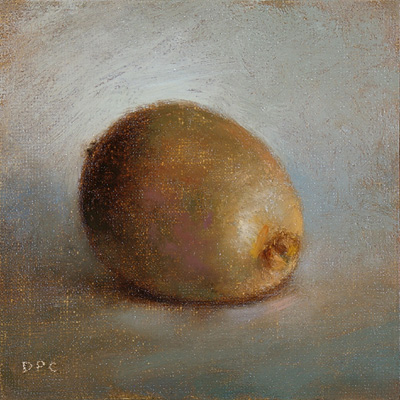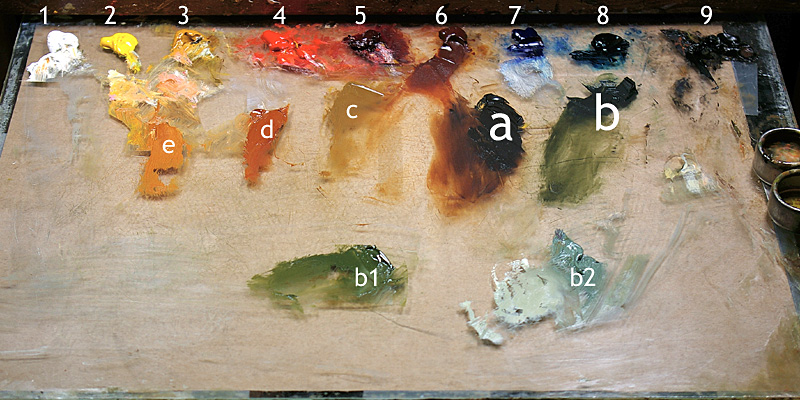
11/17: Kiwi #2, oil on canvas panel, 4x4 in.
As I was going to shoot this I saw there was a lot of light bouncing back from some dull spots in the darkest shadow (this isn't the smooth linen so it was more pronounced). I don't normally do it but I sprayed a little Damar varnish to smooth it out some. I figure this doesn't hurt if the paint layer is still wet, as the Damar would mix in with it and not just sit on top trapping the paint and drying at a different rate. It took care of that dullness but I must have done one spritz too many because it began to liquefy and fan out some of the topmost strokes, like the purplish bits. But oh well, it probably turned out better.
Here's my "standard" palette, which lately hasn't changed much, a sign that I am getting more comfortable - I scraped a lot of the mess away from last night but left the mixed blobs, which I drew out a bit more to show the colors better:
1. titanium white
2. cad. yellow med.
3. yellow ochre
4. cad. red med.
5. alizarin
6. transp. oxide (or earth) red
7. ultramarine
8. Prussian blue
9. ivory black
Alizarin is usually used just for purples and reds, and black practically never (except lately I use it with ochre and maybe a little cad. red if I want a greenish-brown underpainting) - so probably 8 of the 9 colors are actually in the final picture. The one most used is transp. oxide red/red earth, which I learned about from Terry Miura's website - it's like a transparent Venetian red as Gamblin describes, and I've been making my two most important mixes with it: (a) with ultramarine for a transparent dark blue-brown; and (b) with Prussian blue for a semitransparent dark blue-green. (b1) and (b2) are simply (b) mixed with ochre and white, respectively.
These were useful for the kiwis and aren't standard but could be: (c) is yellow ochre added to (a), maybe with more of the red earth. I haven't been mixing it much before last night, but I found it works well for the kiwi skin and would probably be of good use every day. (d) is ochre and red earth. (e) is red earth and cad. yellow.
Sorry if this was confusing. For mediums I'm using Galkyd Lite and/or linseed oil, sometimes Venetian turpentine (tiny glob to the left of the palette cups). I keep telling myself I should go back to using cups with lids, but it may be better to let any remaining bit of Galkyd dry out completely and pour a fresh little amount the next day, than let it dry slowly under cover, creating a gummy mess inside; the linseed oil doesn't really get a chance to dry out.
Sunday, November 18, 2007
Kiwi #2
Posted by
Dan P. Carr
at
1:26 PM
![]()
Tags: daily painting, food, materials, palette
Subscribe to:
Post Comments (Atom)



No comments:
Post a Comment